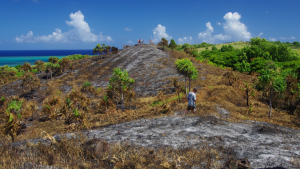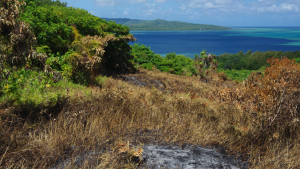Hawaiʻi is not the only Pacific island where wildfire is a concern. Using fire histories, vegetation and soil maps, University of Hawaiʻi at Mānoa wildfire expert Clay Trauernicht led new research that examined the relationships between historical human land use, climate, and fire occurrence across nine Micronesian islands spanning close to 2,000 miles over the Pacific Ocean. The geographic and ecological breadth of the research points to the use of controlled burning by the inhabitants to shape island vegetation.
"We first started looking at fire as a percentage of island area years ago to show how the extent of wildfires in Hawaiʻi are on par with the western U.S.," said Trauernicht who is an extension specialist in ecosystem fire in the UH Mānoa College of Tropical Agriculture and Human Resources Department of Natural Resources and Environmental Management. "Based on that metric, wildfire is far, far more extensive on many islands in Micronesia than in Hawaiʻi."
Findings were recently published in Journal of Biogeography.
Human-crafted landscape

The study indicates that the area burned by fire mirrors the presence of open savanna vegetation on the Micronesian islands. Unlike Hawaiʻi, where introduced grasses dominate savannas, Micronesian savannas consist of native plants. The research suggests that these savanna patterns across the islands were intentionally created by people through controlled burning.
"Almost all ignitions on Pacific Islands are human-caused since lightning strikes are relatively rare. People literally brought fire to the islands and, like everywhere else in the world, used fire as a tool for changing and caring for the landscape."
The study delves into deeper paleoecological histories across the Pacific, demonstrating how human arrival in Micronesia around 3,000–4,000 years ago coincided with significant increases in charcoal and pollen of savanna plant species. Soils were found unlikely to explain vegetation patterns, pointing to human fire use.
While rainfall limits both fire and savannas, the research identifies the most fire-prone islands in the west, such as Palau, Yap, Guam and the Northern Marianas which have the most seasonal rainfall. Islands to the east, like Chuuk, Pohnpei and Kosrae, experience less extensive savannas due to consistent year-round wet conditions.
Climate factors on fire

The study also provides practical applications for assessing and anticipating fire risk in Micronesia.
"Strong El Niños typically result in more intense drought across the region, increasing the risk and impacts of fire," said Abby Frazier, a climatologist from Clark University who co-authored the paper.
Trauernicht emphasized a crucial aspect of the study, hoping for a shift in perception.
"Despite how they're often characterized in western science, savannas in Micronesia are not 'degraded.' They are cultural landscapes shaped through people's relationship with fire. Respecting that relationship requires looking at fire not simply as a threat but understanding how fire use by island peoples is a critical aspect of their knowledge and systems of land care."
This research is funded in part by the Pacific Islands Climate Adaptation Science Center.






